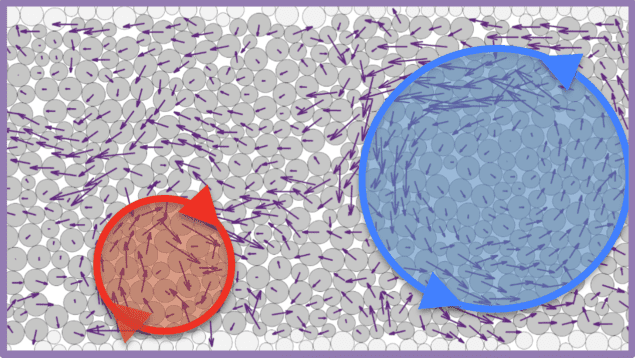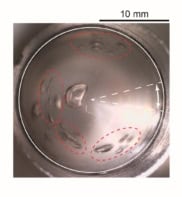
Geological faults could be cooled during earthquakes by the formation of granular vortexes – according to a new study by researchers in Australia and France. The finding could explain why there is little evidence for frictional melting along geological faults and could boost our understanding of how temperature-related phenomena affect active fault systems.
Rising temperatures within fault systems could play a vital role in the motions associated with earthquakes. This is because heat can activate various processes that make fault slippage more likely – including melting, pore fluid pressurization and silica gel lubrication. While fault temperatures have been predicted to rise significantly during earthquakes, evidence of frictional melting along exposed fault gouges is rare. This presents a conundrum: where is the extra heat going?
Now, Itai Einav and colleagues University of Sydney and Laboratoire Navier say they have come up with an answer. They say that the previously-overlooked phenomenon of transient granular vortexes could be cooling faults during earthquakes. These vortexes are known to form in granular materials that are subjected to a shear force. The size of the vortexes is related to grain size, density, stress and strain rate – and the vortexes last for between a fifth and a tenth of an earthquake’s shear time.
Along for the ride
The researchers propose that these vortexes enable convection-based heat transfer in geological faults through the mixing of solid particles. Previously, it was assumed that heat generated at faults during earthquakes could only diffuse away by conduction. “It is simply more effective for heat to move in space as the passenger of grain motions than to molecularly diffuse through grains and contacts,” the team writes in in Geophysical Research Letters.

How to forecast an earthquake
While it is not possible to observe granular vortexes as they occur in real time in fault slips, evidence can be found in the geology of fault planes that connect different rock types. “The effect of the vortexes will be seen through the mixing of the various minerals,” Einav tells Physics World. He points out that an example of this mixing across a fault plane can be seen on the Glarus Fault in the Alps of eastern Switzerland.
To test their hypothesis, Einav and colleagues created their own granular vortexes in the laboratory by using a stadium shear device. This is a belt system that applies shear to a series of granular discs set on a glass plate. By tracking disc motion and larger-scale eddy evolution, the team could model the impact vortexes would have on the thermal evolution of faults during slip events. The researchers then applied their model to a case study by looking at California’s active San Andreas fault system.
1000-fold boost
“Transient granular vortexes can boost the effective thermal diffusivity of earthquake faults by a factor of up to 1000 times,” says Einav. As a result of this, he adds, “crustal faults such as those in the San Andreas system may experience a maximum temperature rise 5-10 times smaller than previously thought.”
Reduced temperatures could delay the thermal activation of fault weakening mechanisms, leading to faults that are stronger – at least temporarily. Future investigations into earthquakes, Einav says, will need to reassess the role of the different fault-weakening mechanisms in light of the impact of granular vortexes.
Game changer
“This is a game changer in the mechanics of earthquakes,” says Christopher Scholz, a geophysicist at Columbia University in the US. He adds, “This mechanism for convective heat transport within the cataclastic core of faults during seismic slip readily explains a host of previously enigmatic problems: the scarcity of friction melt in faults, the lack of a conductive heat flow anomaly over the San Andreas fault, and the lack of evidence for thermal weakening in earthquakes.”
With their initial study complete, Einav and colleagues are planning further experiments with more realistic test materials. They are also evaluating how the presence of granular vortexes would impact the various fault weakening mechanisms and larger-scale earthquake dynamics.



